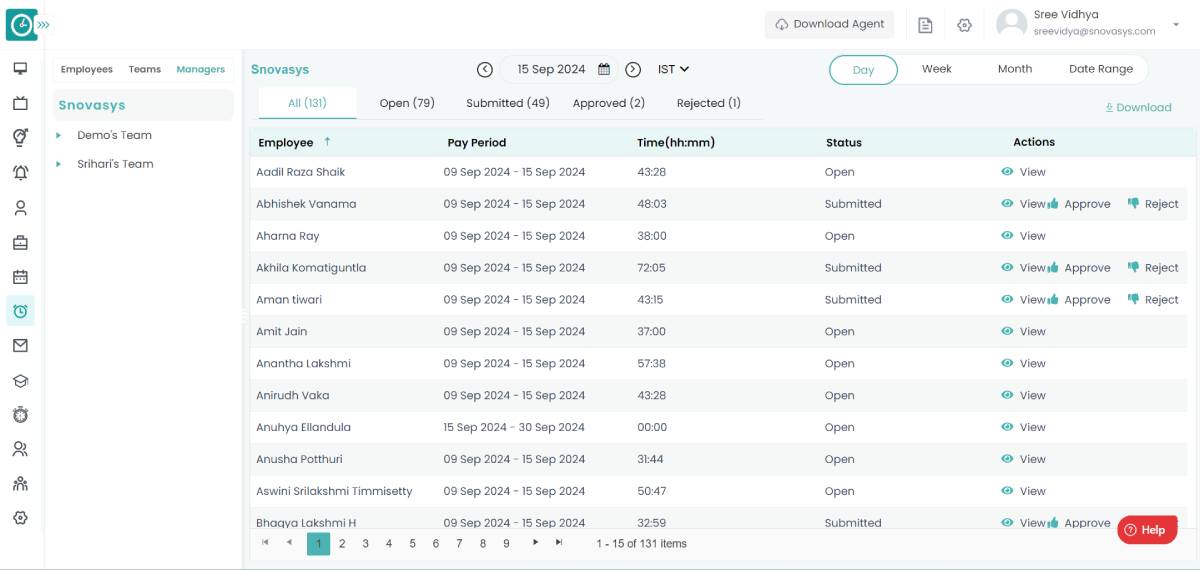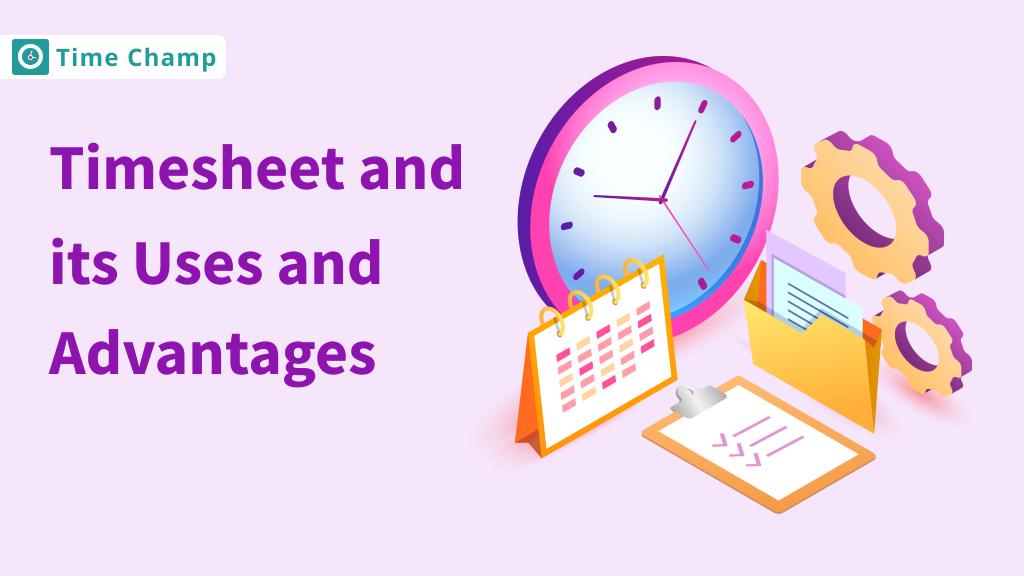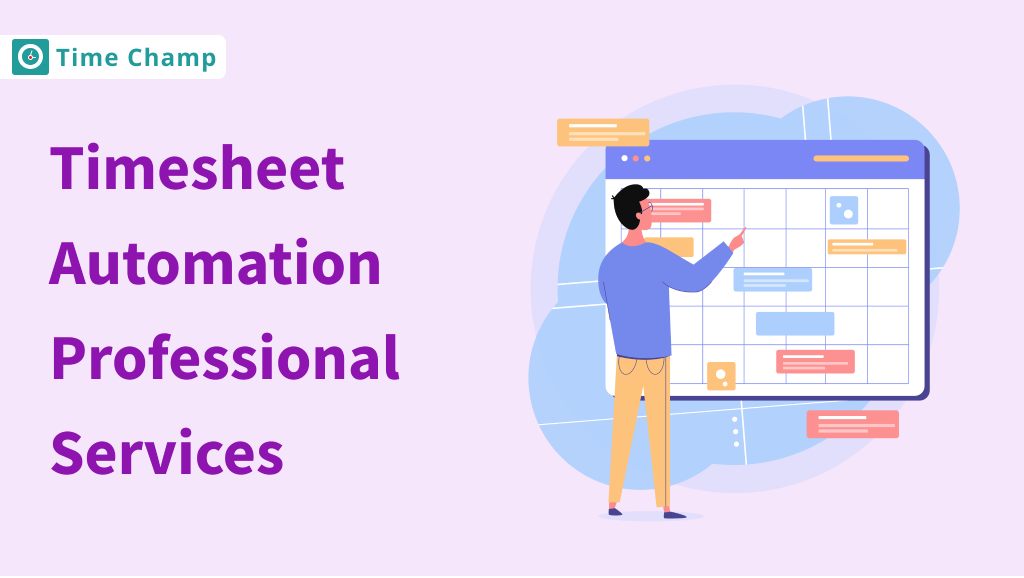Curious about how businesses keep
track of work hours and manage
projects effectively?
Enter
the world of timesheets!!
Timesheets
are essential for recording employee
hours, streamlining payroll, and
optimizing project management.
Understanding their benefits can
transform how you manage time and
resources.
Dive in to learn
what timesheets are, how they work,
and why they’re a game-changer for
any organization.
What is a Timesheet?
A timesheet is a simple record of the
hours an employee works. It shows
when they start and finish work,
take breaks, and what tasks or
projects they do. Companies use
timesheets to make sure employees
are paid the right amount and to see
how time is being used.
Timesheet can be filled out
every day, week, or month, depending
on company requirements. Many
companies now use online or digital
timesheets, which make it easier to
track time and avoid mistakes.
Timesheets also help companies see
how work is going and plan for the
future.
What are the Types of Timesheets?
There exist different types of
timesheets where organizations use
them according to their requirement.
Let’s have a look at them:
1. Daily Timesheets
Daily timesheets are more comprehensive and record the number of hours an employee has worked on a particular day. They usually contain fields for the date, clock-in and clock-out time, and any breaks taken (if applicable) so that the daily work schedule can be recorded accurately.
Daily timesheets help in the proper documentation of working hours for payroll, compliance, and project tracking. These timesheets are important in a dynamic work environment where tasks may vary day by day.
2. Weekly Timesheets
Weekly timesheets contain the working hours of an employee for the entire week. Every week, the timesheet gives a summary of the number of hours that an employee has spent on various tasks, which is useful in the processing of payrolls and in analyzing work patterns.
3. Bi-weekly Timesheets
These are documents that contain the working hours of employees over two weeks. This type of timesheet is ideal for organizations with bi-weekly payroll systems. Bi-weekly timesheets are preferred by small businesses because of their simplicity and they are in line with the normal payroll frequency.
4. Monthly Timesheets
Monthly timesheets contain the total working hours of an employee over a full month. This type of timesheet is commonly used by many organizations as it is important to generate payroll.
Many organizations prefer this rather than maintaining other types of timesheets as it gives broader data in a single timesheet.
Every type contributes unique results to the organization. It is recommended to choose the type of timesheet based on your organization’s needs and requirements.
Uses of Timesheets
1. Tracking Employee Hours
Timesheets track
the number of hours each
employee spends at work by
recording their start and end times,
including any breaks. This ensures
that employees are paid accurately
for the time they work, helping to
avoid payroll mistakes and ensuring
everyone receives the correct
amount.
Moreover, timesheets
help in attendance pattern that you
can be able to track late arrivals,
early leaving, or frequent absences,
resulting in workforce planning and
maintaining productivity. Timesheets
can be combined with leave
management systems for tracking PTO,
sick days, and vacation days to
ensure the number of paid time off
accorded to an employee in payroll
while proper compensation is
included.
Project Management
In managing
projects, timesheets
indicate the amount of time spent on
various activities and projects.
This is useful in monitoring
progress and ensuring that all the
set goals and timelines are
achieved. It also helps plan how to
use resources and changes in the
schedule. Thus, you can understand
where time is being spent and
address any issues that may
arise.
Timesheet data also
allows better forecasting and
budgeting. From the analysis of past
records
of timesheets, organizations
can predict future timelines
for the projects undertaken
and can allocate more effectively.
Cost
estimation can also be done
as it links with billing systems in
order to trace the billable hours
for client-based work.
Performance Analysis
Timesheets can help assess employee
productivity by revealing
how much work has been accomplished.
You can evaluate what is effective
and what is not regarding time
spent on various tasks. This
information is valuable for setting
objectives, performance
appraisals, and making
decisions about staffing and
development.
Analysis of
timesheet data can be used in
evaluating process efficiency and
different
times-wasting activities to
implement streamlining of processes
for overall productivity
enhancements. This data is
especially useful to review the
performance as objective evidence of
an employee’s contribution to
the company. It helps to set more
accurate performance
goals for employee’s
professional growth and development.
Compliance and Labor Law Adherence
Many companies have rules or
regulations on break
times, overtime, and working
hours. Timesheets assist companies
in keeping track of how long their
employees spend in the workplace,
thus saving business from breaking
the law either by overpaying,
underpaying, or holding them back
for too long, thus not giving
employees adequate time
off.
Timesheets also provide
necessary documentation, which is
crucial when there are audits or
disputes with the regulatory
authorities. In industries that put
severe overtime regulations, such as
healthcare or manufacturing,
timesheets ensure that no one is
overworked, and all extra hours are
paid.
Manual Timesheet vs. Digital Timesheet
People often struggle to choose between manual and digital timesheets. Well, if you are also stuck in this situation like they are, you need to read this.
| Feature | Manual Timesheets | Digital Timesheets |
|---|---|---|
|
Format
|
Paper-based
or
handwritten
|
Software
or
app-based
|
|
Ease of
use
|
Requires
manual
entry
and
calculation
|
Automated
calculations
and
user-friendly
interfaces
|
|
Error
rate
|
High
chances
for
errors
and
inaccuracies
|
Low
chances
for
errors
|
|
Accessibility
|
Requires
physical
presence
and
storage
|
Accessible
from
multiple
devices
|
|
Data
management
|
Harder
to
organize,
store,
and
retrieve
records
|
Easier
to
organize,
store,
and
retrieve
records
|
|
Tracking
and
reporting
|
Manual
compilation
and
recording
|
Automated
recording
and
real-time
tracking
|
|
Security
|
Physical
security
is
required
for
paper
records
|
Digital
security
measures
such as
encryption
and
assess
controls
|
|
Cost
|
Low
initial
cost
|
High
initial
cost
|
|
Flexibility
|
Less
flexible,
difficult
to
modify
the
records
|
More
flexible,
easily
updated,
and
modified
|
Benefits of Manual Timesheets
- Simplicity: Simple to use and does not require much technical support and specific software or hardware.
- Low Cost: No need to purchase any expensive tools, just paper and a pen.
- No Technical Issues: Eliminates issues concerning software glitches, system failure, or technical assistance.
- Tangible Records: Physical documents are helpful in some cases when it is impossible to obtain a digital copy.
Benefits of Digital Timesheets
- Efficiency: Saves time on tracking time spent on tasks and calculating the time to be billed, thus minimizing the time spent on administrative work and the chances of making mistakes.
- Accessibility: Enables the use of different devices and places, which is convenient for employees who work from home or in the field.
- Integration: It can be easily integrated with payroll, project management, and HR systems to enhance the efficiency and effectiveness of the processes.
- Reporting and Analysis: Enhances the reporting and analysis capabilities for improved productivity and project tracking.
As we have seen, each type of
timesheet has its advantages and
value. It depends on the
organization’s needs whether
to use manual or digital
timesheets.
However, in today’s
world, the use of digital timesheet
is more beneficial as compared to
manual timesheet.
Advantages of Using Timesheets
1. Improves Accuracy
Maintaining accurate records of the working hours of the employees minimizes the chances of making mistakes in the computation of the payroll. When the exact hours are tracked, it becomes easier to pay the employees the right amount for the hours they have worked. The chances of over or under-compensating someone are reduced and this helps in keeping the financials of the organization accurate and fair.
2. Enhances Accountability
When employees know that their working hours are being recorded, they are likely to be more disciplined and productive in their tasks. Since attendance and working hours are being recorded, employees are motivated to report work on time and diligently throughout the day. This results in a more disciplined workforce and can go a long way in enhancing productivity within the organization.
3. Better Resource Management
Measuring the time and resources spent in an organization helps to understand how they are used and thus helps them make better decisions on their use. This way, you can understand how employees use their time and allocate resources where they are most required. This insight helps in the proper allocation of tasks and in the proper use of resources in the best way possible, thus improving operational performance.
4. Efficient Billing
For companies that operate on an
hourly basis, it is important to
keep track of the timesheets to
ensure that the right amount is
charged to the client, and the right
cost is assigned to the project.
Service-based businesses need
to charge clients for the time spent
on their projects. Proper time
records help in billing the clients
appropriately for the services
offered and in turn, the business
gets paid for the work done. This
precision in billing assists in the
management of good client relations
and financial credibility.
Why is it Important for Payroll System?
Timesheets are the backbone of any effective payroll system. Let’s have a look at how it helps to generate payroll:
- Submit the timesheet
- Validate the timesheet
- Approve/reject the timesheet
- Forward for payroll processing
As we know, timesheets contain information about the employee hours worked for projects. It depends on the organization’s requirement when to submit timesheets to the manager at the end of the period (it can be daily, weekly, bi-weekly, or monthly). Upon approval, it is forwarded to payroll processing.
1. Accurate Compensation
Timesheets offer a detailed record of the time spent at work, making it easier to remunerate the employees fairly. This is important in calculating wages as much as the work that has been done.
2. Overtime Tracking
Overtime hours are recorded through timesheets, this is useful in determining extra wages for hours worked beyond the standard working hours.
3. Budgeting and Cost Management
With timesheets, an organization can determine the amount of money spent on employees and the efficiency of the employees and hence make the right decisions in terms of staffing and utilization of resources.
Why Time Champ is the Perfect Fit for Your Organizational Needs?

Time
Champ stands out as the
perfect solution for effective
timesheet management,
offering a comprehensive suite of
features designed to meet the
diverse needs of an organization.
Time Champ tracks
the employee time and generates
timesheets automatically. It
provides an overall detailed report
of the employees’ worked
hours. The dashboard is quite simple
and easy to understand for any user.
They can be viewed in day, week,
month, or any custom range as per
requirements. This flexibility makes
it possible to examine the hours
worked.
Time Champ’s impressive features give
businesses a clear picture of how
time is being spent, the progress
made on a project, and the performance
of the team, thus helping
businesses enhance their operations
and make good decisions. Also, Time
Champ can integrate with Jira,
Trello, Azure DevOps, and Basecamp
to make the processes easy and
simple.
Overall, Time Champ is
an efficient tool with a
user-friendly interface that helps
organize the work process, increase
productivity, and expand the scale
of the company’s operations, which
in turn contributes to growth and
success.
Conclusion
Timesheets are essential for managing working timesheets, projects, and payments. Manual timesheets are basic and inexpensive, but digital timesheets are precise and convenient. For better and accurate results, it is recommendable to use digital timesheets.
Looking for an effortless way to handle timesheets and boost productivity?
Discover how Time Champ can revolutionize your timesheet process. Try it today!
Signup for FreeBook Demo




